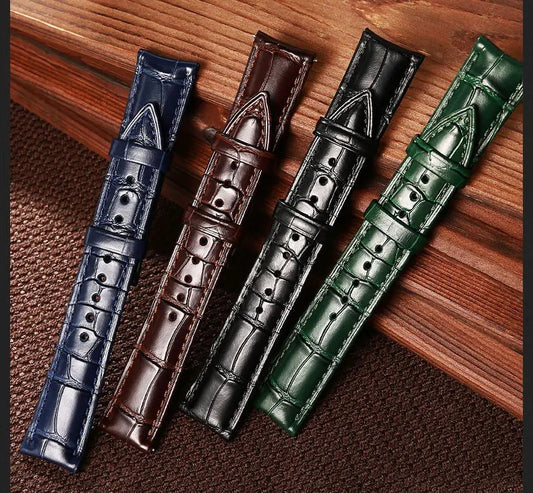
The Role of Texture in Watch Straps
Aktie
The humble strap is an often overlooked component when it comes to enjoying and appreciating your precious watch. However, it plays a crucial role in both the aesthetic appeal and comfort of your timepiece. One key aspect of watch straps that significantly impacts their overall quality is texture.
In this blog post, we'll explore how texture influences the appeal and comfort of watch straps, helping you make informed decisions when choosing your next watch accessory.
Visual Appeal of Textured Watch Straps
Texture adds depth and character to watch straps, elevating them from mere functional components to stylish accessories in their own right. The visual interest created by textured surfaces can complement or contrast with the watch face, creating a harmonious overall design.

Popular textured materials include leather, rubber, and fabric. Leather watch straps might feature a pebbled grain or a smooth finish, each conveying a different aesthetic. Rubber watch straps often incorporate patterns for both style and grip, while nylon watch straps can range from tightly woven nylon to rough canvas textures. Each material and texture combination offers a unique visual appeal, allowing you to express your personal style through your choice of watch strap.
Tactile Experience
The tactile experience of a watch strap is closely tied to its texture. Psychology studies have shown that touch plays a significant role in how we perceive product quality. Research by Peck and Childers (2003) demonstrated that the need for touch in product evaluation varies among consumers and can significantly influence purchase decisions[1]. A well-textured strap can evoke feelings of luxury, durability, or sportiness, depending on its characteristics.
Texture influences the perceived quality of a watch strap in several ways. A study by Klatzky and Peck (2012) found that texture can convey information about product properties such as durability and quality[2]. A finely grained alligator leather strap might feel more premium than a smooth one, while a textured FKM rubber strap could convey a sense of durability and adventure. The right texture can make a watch feel more expensive and desirable, enhancing your overall satisfaction with the timepiece.
Comfort Factors
Comfort is paramount when it comes to watch straps, as you'll likely be wearing your watch for extended periods. Texture plays a crucial role in determining how comfortable a strap feels against your skin.
Air circulation and moisture management are directly affected by a strap's texture. A strap with a more open texture allows air to circulate, reducing sweat buildup and improving overall comfort. Moreover, certain textures can help reduce skin irritation. For example, a slightly raised pattern on a silicone rubber strap can minimise skin contact, preventing the strap from sticking to your wrist during physical activities.
Durability and Longevity
The texture of a watch strap can considerably impact its durability and longevity. Different textures wear differently over time, affecting both the appearance and functionality of the strap.
Some textures are more resistant to wear and tear than others. For instance, a deeply grained Italian leather strap might hide scratches better than a smooth one. Similarly, textured rubber straps can maintain their appearance longer than their smooth counterparts. However, it's worth considering that more pronounced textures might collect dirt more easily, requiring more frequent cleaning to maintain their appearance.
Matching Texture to Watch Style
Selecting the appropriate texture for your watch strap is essential in complementing the overall design of your timepiece. The texture should harmonise with the watch face design, enhancing its aesthetic appeal rather than clashing with it.
For formal watches, consider finer textures like smooth or subtly grained leather. These textures exude elegance and sophistication, perfect for dress watches. For casual or sports watches, you have more freedom to experiment with bolder textures. Rubber dive watch straps with pronounced patterns or parachute elastic straps with visible weaves can add a sporty or adventurous flair to your timepiece.
Innovative Textures in Modern Watch Straps
The watch industry continues to innovate, and strap textures are no exception. New materials and manufacturing techniques are expanding the possibilities for watch strap textures.
Some brands are experimenting with composite materials that offer unique textures while improving durability and comfort. Others are using advanced manufacturing techniques to create micro-textures that enhance grip and breathability. Many companies now offer customisation options, allowing you to choose or even design your own strap texture, ensuring a truly personalised watch experience.
Final Thoughts
Texture plays a crucial role in both the appeal and comfort of watch straps. It influences visual aesthetics, tactile experience, comfort, durability, and style compatibility. As you shop for your next watch or consider upgrading your current strap, pay close attention to texture. It's not just about how the strap looks, but how it feels against your skin and how it complements your overall style.
The future of watch strap textures is promising, with ongoing innovations offering even more options for personalisation and performance. By understanding the importance of texture, you're better equipped to choose a watch strap that not only looks great but feels fantastic on your wrist, improving your overall enjoyment of your timepiece.
Explore our wide range of watch straps to find the perfect texture for your style and comfort needs. Whether you're looking for a classic leather strap, a sporty rubber option, or a durable nylon band, we have textures to suit every preference.
References:
[1] Peck, J., & Childers, T. L. (2003). Individual differences in haptic information processing: The "need for touch" scale. Journal of Consumer Research.
[2] Klatzky, R. L., & Peck, J. (2012). Please touch: Object properties that invite touch. IEEE Transactions on Haptics.




